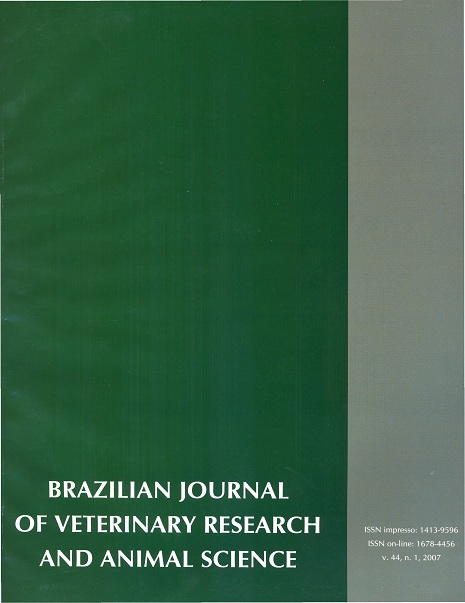Utilization of modified agglutination test and indirect immunofluorescent antibody test for the detection of Toxoplasma gondii antibodies in naturally exposed horses
DOI:
https://doi.org/10.11606/issn.1678-4456.bjvras.2007.26657Keywords:
Toxoplasma gondii, Equine, Serology, IFAT, MATAbstract
Infection by Toxoplasma gondii in equines is usually not apparent, it being characterized by presence of antibody titers and tissue cysts. This study was aimed at verifying the presence of anti-Toxoplasma antibodies in equine serum by modified agglutination test (MAT) and reaction to indirect immunofluorescent antibody test (IFAT). 1984 samples of serum were examined, by MAT, using whole formalin fixed tachyzoites of T.gondii as antigen. The samples reacting in the MAT test, and 150 other negative samples, chosen at random, were also tested by IFAT, utilizing anti-equine IgG. The association among the test results was verified by the McNemar test. 138 samples were positive in the MAT test, with 60 (46.38%) presenting reaction at a dilution of 1:64; 52 (37.7%) at 1:256; 19 (13.8%) at 1:1024; five (3.6%) at 1:4096; and two (1.45%) at 1:16384. Of 132 positive MAT samples, 14 were negative in the IFAT test, but the statistical analysis indicated general agreement in results of the tests. The results obtained showed agreement among the tests utilized, and the possibility of participation of equines in the transmission of toxoplasmosis to carnivorous animals, and also to humans.Downloads
Download data is not yet available.
Downloads
Published
2007-02-01
Issue
Section
UNDEFINIED
License
The journal content is authorized under the Creative Commons BY-NC-SA license (summary of the license: https://
How to Cite
1.
Langoni H, Silva AV da, Pezerico SB, Lima VY de. Utilization of modified agglutination test and indirect immunofluorescent antibody test for the detection of Toxoplasma gondii antibodies in naturally exposed horses. Braz. J. Vet. Res. Anim. Sci. [Internet]. 2007 Feb. 1 [cited 2024 Jul. 26];44(1):27-32. Available from: https://www.revistas.usp.br/bjvras/article/view/26657





